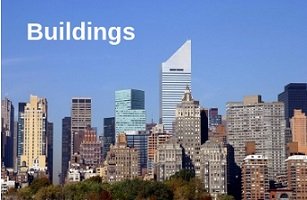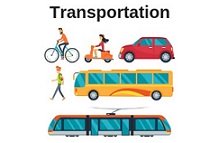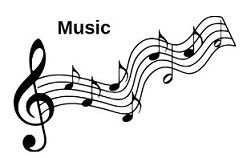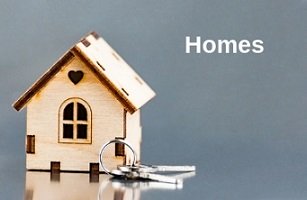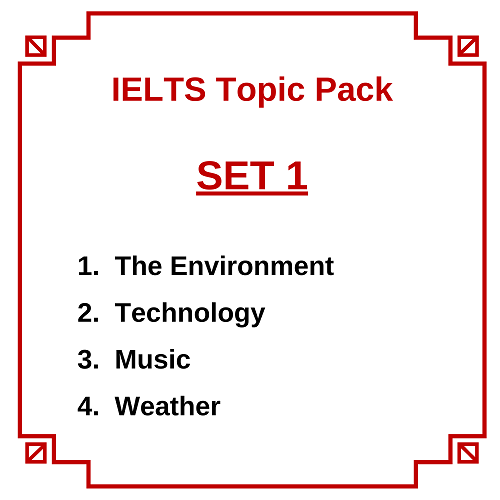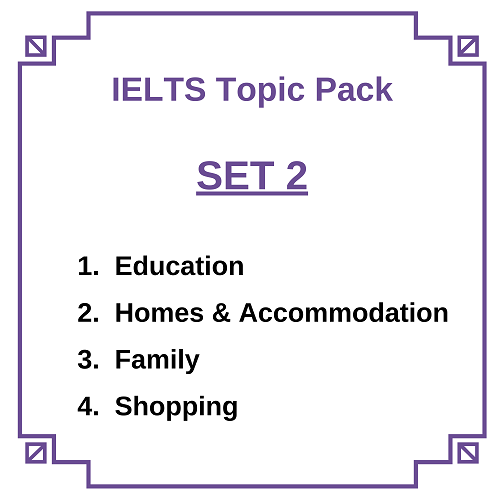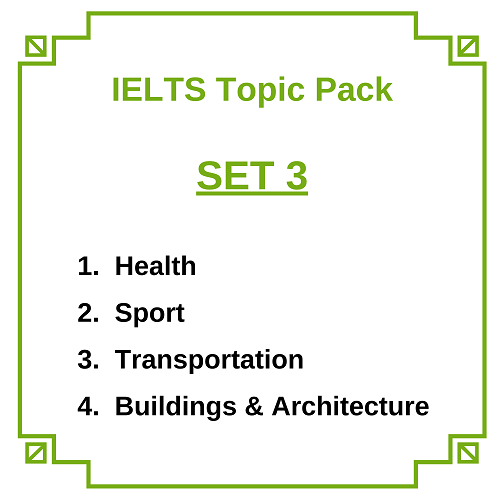Buildings Vocabulary
Buildings vocabulary is particularly useful for answering Part 1 Speaking questions as you are very likely to get asked about your home or your home town. Buildings and different styles of architecture can also come up in Speaking Parts 2 and 3 as well as forming the topic of Writing, Reading or Listening questions.
Here are a few things you
could be asked about:
- The style of house you live in
- Landmark buildings in your home town
- Your interest in architecture
- A historic building you have visited
- A modern building you like
- The historical value of old buildings
- The role of architecture in society
- How technology influences building design
This page of contains over 100 common words and phrases which is more than enough buildings vocabulary for you to answer any question related to buildings and architecture.
I’ve also added an explanation for each one and a sample sentence to show it in context. This will help you to learn how to use it correctly.
Don’t try to learn them all. Look at my suggestions below as to the best way to use this comprehensive list of vocabulary.
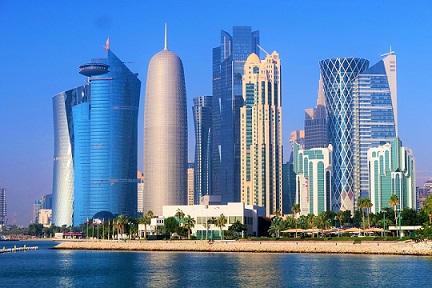 Modern building materials enable architects to create a wide variety of different architectural styles.
Modern building materials enable architects to create a wide variety of different architectural styles.To help you create the best possible answers, I’ve included four things here:
- IELTS-style questions on the topics of buildings and architecture
- Sample answers
- A list of common buildings vocabulary with definitions & sample sentences
- Links to online reading and listening resources
You’ll find PDF downloads of both the questions and sample answers and the buildings vocabulary list at the bottom of the respective sections.
The questions relate to the Speaking test because this part of the exam offers the broadest range of possible questions on this topic. They give the best opportunity for me to demonstrate the vocabulary and for you to practise using it.
I’ve included IELTS-style questions and answers for all three parts of the Speaking test. I've highlighted keywords and phrases in bold.
You'll find these words and phrases, and many others, in the vocabulary list beneath. The list also includes explanations and sample sentences and there’s an audio to listen to the pronunciation.
The buildings vocabulary list contains words and phrases relevant to all parts of the IELTS exam.
Finally, at the bottom of the page, I've added links to topical articles, short videos and podcasts that will help you to improve both your vocabulary and your reading and listening skills.
IELTS-Style
Speaking Test Questions and Answers
Common buildings vocabulary is highlighted in bold.
Part 1
1) What types of
buildings are there where you live?
In the town, there are lots of Victorian houses constructed from locally made bricks and some modern shops and offices. We certainly don’t have any high-rise apartments or skyscrapers in the area.
2) Are there any monuments in your hometown?
The most famous monument is a clock tower called the Albert Clock in memory of Prince Albert the husband of Queen Victoria. There’s also a war memorial in the park.
3) Do you like to visit historic buildings?
Yes, I particularly enjoy visiting old manor houses and I’m lucky that there are several interesting ones in the area where I live. I also like looking around old ruins both in my own country and abroad.
4) What are the landmarks in your hometown?
I’d say that there are three – a church with a tall steeple, a six-storey office block that’s an ugly monstrosity and a hill that used to have an old castle on it.
5) Have you ever visited a famous structure?
When I was in Australia, I went to the Sydney Opera House. It’s the most stunning piece of architecture I’ve ever seen and such an iconic building.
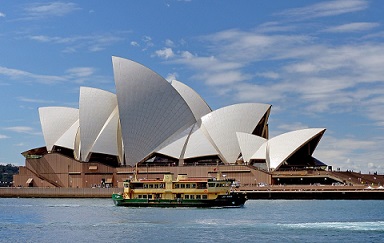 Syndey Opera House is one of the most iconic buildings in the world.
Syndey Opera House is one of the most iconic buildings in the world.Part 2
Describe a style of architecture that you like.
You should say:
- what style it is
- what it looks like
- where you can see it
and explain why you like this style.
I like many different styles of architecture but my favourite is probably Art Deco. The exterior of buildings designed in this style generally looks symmetrical. They’re not at all ornate, in fact, you’d say they were quite plain. Yet I find them so beautiful, with elegant lines and simple shapes.
The façade is often decorated with geometric patterns created from straight lines or from stylised designs based on plants, animals and sunrays like you see on Art Deco furniture, jewellery and other artefacts of the 1920s and 1930s when the style was developed. The most popular building material was concrete but glazed brick was also used.
Architects designed Art Deco houses, public buildings and commercial buildings and most of them are still standing today. During the 20s and 30s, many cinemas were built in towns and cities across the country. Lots of them closed down when new multiplex movie theatres were constructed. Some fell into disrepair and had to be demolished but others have been renovated for use as shops and their Art Deco features preserved. There is one in my town which is now a night club.
Although it’s long past its heyday, Art Deco has remained popular as a design style and you can sometimes see it in modern buildings. For example, the new bus station in my town has many Art Deco features, in particular, the style of the windows, the shape and symmetry of the building and the decoration around the large clock set in the wall.
For people who are real fans of Art Deco architecture, I recommend that they visit the town of Napier in New Zealand because almost every building is Art Deco. It’s an amazing place. They have tour guides to show you around and tell you about the history of the town. Sadly it was destroyed in an earthquake in 1931 and completely rebuild in the architectural style of the day – Art Deco. I don’t think there is anywhere else in the world like it and I’m sure that it was my visit there that really got me interested in this beautiful architectural style.
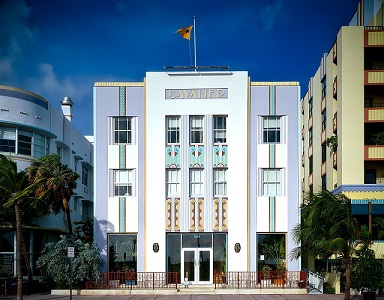 A typical Art Deco building.
A typical Art Deco building.Part 3
1) What kinds of people like to visit historic buildings?
In my country, people of all ages and from many different backgrounds enjoy looking around historic buildings. At the weekends and during school holidays they are popular with families who visit for a day out. Many old manor houses have extensive grounds which are ideal for the kids to run around and play in.
Lots of historic sites offer educational tours and activities for schools as they are the perfect place to learn about how people lived in the past. So, most historic houses get school trips visiting. Old castles are particularly popular with school kids.
Another common group of visitors is retired people because they have plenty of time for leisure activities. I think they are attracted by the tearooms as much all the interesting things there are to look at and learn about as most historic houses have one and they always serve delicious cakes.
Finally, I mustn’t forget the tourists. For the most famous historic buildings, they are the largest group of visitors.
2) Do you think it’s worth the money to preserve old buildings?
That’s such a difficult question to answer. It costs millions of pounds to preserve historic buildings and there are many other important things that the money could be spent on. I suppose it depends where the money comes from.
I think it’s true to say that most of the money spent on restoring and maintaining the old properties in my country comes from donations, entrance fees and charitable funds. People want to visit historic buildings and are happy to pay for them to be looked after. If the government was responsible for their upkeep, it would be more difficult to justify the huge costs involved.
Of course, historic properties are part of our heritage and that’s important preserve. They also attract a large number of overseas tourists who contribute a significant amount to our economy.
So, weighing it up, I’d have to say that I do think it’s worth the money to preserve old buildings.
3) How have buildings changed in the past few years?
As far as houses are concerned, there are 3 main differences that I can think of. First, it’s now common to see three-storey homes on new housing estates which you never used to get and there are not so many bungalows being built. This is because there is less building land available than, say, twenty years ago.
Second, new houses are more eco-friendly, with better insulation and improved double glazing to make them more energy efficient.
Third, there are new rules concerning things like the width of doors and the height of switches so that new properties are wheelchair friendly.
With regard to public buildings and commercial buildings, the development of stronger building materials and new construction techniques means that architects are beginning to design more Futuristic buildings.
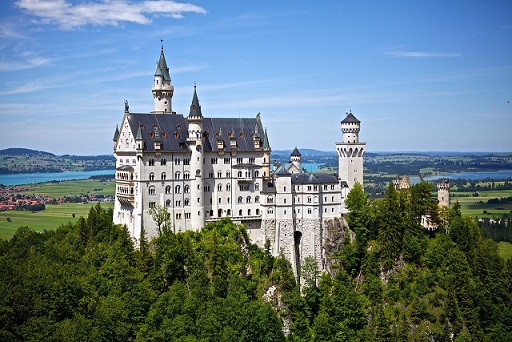 Neuschwanstein Castle in Germany is one of the most famous historic buildings in the world.
Neuschwanstein Castle in Germany is one of the most famous historic buildings in the world.Click this link to get a PDF download of these practise questions & sample answers.
Buildings Vocabulary
* Important
- Do not try and learn this list of buildings vocabulary.
- Identify the vocabulary you find useful for answering practise questions about buildings and architecture.
- Record these in your vocabulary notebook and practise using them regularly.
I recommend that you create
your own answers to the Speaking questions on this page. You will find many
other IELTS-style practise questions by searching online.
For help on how to learn
vocabulary, what to learn and how to record it, visit these pages:
How to Learn Vocabulary for IELTS
Top 6 Types of IELTS Vocabulary & Topic Word Lists
Buildings Vocabulary – Common Words & Phrases
Buildings Vocabulary Set 1: Key definitions
building – a structure that has a roof and walls
- There used to be a field behind my house but now it’s covered in buildings.
architecture – the practise of designing buildings; the style in which buildings are made
- Paulo studied architecture at university before joining the family building business.
- My favourite style of architecture is Georgian because it is bold and beautiful but not too ornate.
architect – a person who designs buildings
- Tammy’s friends laughed when she said she wanted to design houses when she left school but she grew up to be an award-winning architect.
feature – a distinctive attribute or aspect of something
- The best feature of the new church in our town is the stunning, modern spire.
façade – the front of a building, especially a large or attractive building
- The British Museum in London is famous for its grand Classical façade.
landmark – an object or building that is easily seen and recognized from a distance, especially one that enables someone to establish their location
- The Eiffel Tower is probably the best-loved landmark in Paris.
heritage – things, such as buildings and traditions, that are important to a nation's history
- Some people complain that large historic houses cost a lot to maintain but they are part of our heritage and should be preserved.
Buildings Vocabulary Pronunciation
Buildings Vocabulary Set 2: Building Materials
building material – any material which is used for construction purposes
- The house would look fabulous when it was finished but at the moment it was little more than a pile of building materials.
brick – a small rectangular block typically made of fired or sun-dried clay, used in building
- They decided to build their house with bricks rather than concrete blocks.
concrete – building material that is made by mixing together cement, sand, small stones and water
- Concrete is a very popular building material because it is strong and can be moulded into different shapes.
reinforced concrete – concrete with metal bars or wire embedded in to increase its strength
- Reinforced concrete is the perfect material for constructing large structures such as tower blocks and bridges.
steel – a strong hard metal that is made of a mixture of iron and carbon
- Modern architects such as Zaha Hadid use steel to create stunning Futuristic designs rather than just using it to form the hidden framework of a building.
timber – wood that is prepared for use in building
- In Sweden, timber is a popular building material because they have lots of forests.
stone – a hard, solid substance found in the ground, used for building
- Stone has been used as a building material for centuries.
glass – a hard, brittle, man-made material that you can see through
- These days, they can make glass that is so strong that you can have whole walls made out of it.
marble – a type of hard stone, often with a beautiful lined pattern going through it, that can be highly polished
- The Taj Mahal is the most famous building in the world made from marble.
Buildings Vocabulary Pronunciation
Buildings Vocabulary Set 3: Types of building
See my Home Vocabulary list for 18 different types of house/accommodation.
Other types of building:
manor house – a large country house surrounded by land that belongs to it
- It’s so nice to see the old manor house being renovated after the previous owners let it fall into disrepair.
castle – a strong building, often large, built in the past by a ruler or important person to protect the people inside from attack
- Most castles were built on a hill so that the occupants could see the enemy approaching.
sky-scraper – a very tall building
- With the development of stronger building materials, they are able to build skyscrapers higher and higher.
office block – a building made up of many different offices, often of different companies
- Many old buildings in the city are being demolished to make way for smart new office blocks.
warehouse – large building built for the storage of raw materials or manufactured goods before they are distributed for sale
- There is a real trend for converting old warehouses into fashionable apartments.
public building – a building owned by the state or local government and used by the public, e.g. townhall, library, museum, leisure centre
- Many public buildings are quite old and cost a lot of money to maintain
commercial building – buildings that are used for commercial purposes, such as, office blocks, shops and warehouses
- Most of my architect friends design houses but I much prefer working on commercial buildings.
prefabricated building (prefab) – buildings that are made in sections in a factory and can be put together quickly
- Prefabs were popular after the war when many new homes had to be built quickly but are coming back into fashion with new technology and modern designs.
historic building – an old building that is important to history
- We are fortunate in my country to have many magnificent historic buildings.
a ruin – a building reduced to a state of decay and collapse
- One of the most visited historic sites in the world is the Inca ruins at Machu Picchu in Peru.
monument – a statue, building, or other structure erected to commemorate a notable person or event, often of historical importance
- India gate is one of the most recognisable monuments in India.
Buildings Vocabulary Pronunciation
Buildings Vocabulary Set 4: Features of buildings
column – large, upright pillar, typically cylindrical, supporting the upper part of a building
- The huge columns of many ruined Greek temples are still standing today.
pillar – a tall vertical structure of stone, brick, wood, or metal, used as a support for a building
- The roof was supported by two rows of brick pillars.
arch – a curved symmetrical structure spanning an opening and typically supporting the weight of a bridge, roof, or wall above it
- Old churches are one of the best places to see impressive arches.
steeple – a tall pointed roof, usually on a church
- The church steeple could be seen for many miles away from the town.
spire – similar to a steeple but usually a narrower structure
- Skyscrapers such as the Shanghai World Finance Center often have a spire built on top to make them taller and thus increase their prestige.
tower – a tall, narrow building, either free-standing or forming part of a large building such as a church or castle
- There was an amazing view over the city from the top of the tower.
dome – a rounded roof
- The dome of the Hagia Sophia in Istanbul is one of the most recognisable domes in the world.
balcony – a platform enclosed by a wall or bars on the outside of a building, with access from an upper-floor window or door
- My dream home would have a balcony overlooking the sea.
Buildings Vocabulary Pronunciation
Buildings Vocabulary Set 5: Popular styles of architecture
(These words are all proper nouns so start with a capital letter.)
Classical – characteristic of the architecture of ancient Greece and Rome
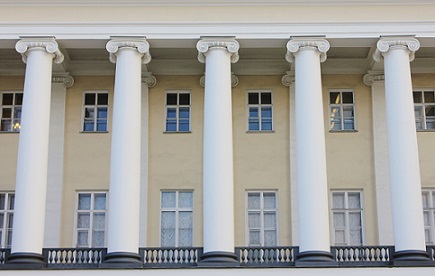
Gothic – characterised by large expanses of glass, clustered columns, sharply pointed spires, intricate sculptures and pointed arches
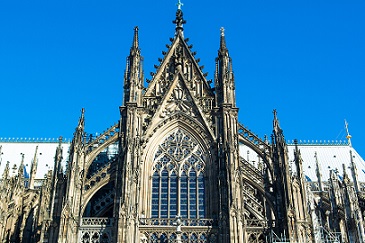
Georgian – based on the simple elegance of classical architecture, with little ornamentation. Symmetry of design was important.
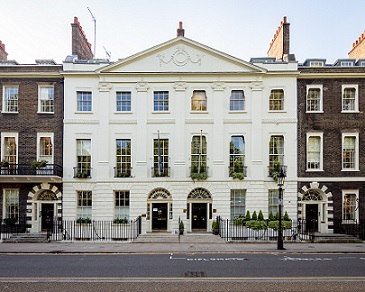
Victorian – characterised by sash windows set in bay windows, an asymmetrical shape, bright colours and decorative features
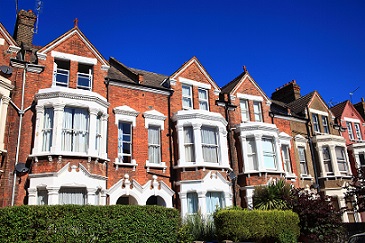
Art Deco – characterised by simple, clean shapes, usually with a ‘streamlined’ look and decoration that is geometric or stylised forms of plants, animals and sunrays
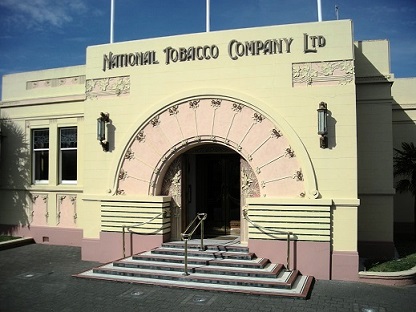
Islamic – known for its arches, domes, minarets, geometric designs, courtyards and often colourful tile decoration
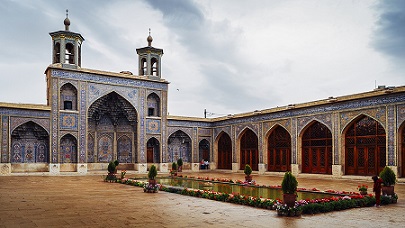
Modernist – typically characterized by simple designs in glass, steel and reinforced concrete and no ornamentation
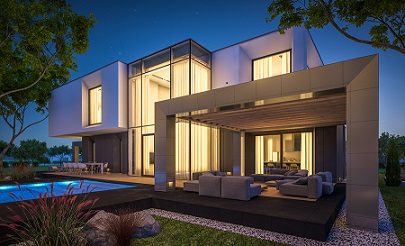
Futuristic – extremely modern and unusual in appearance, as if belonging to a future time
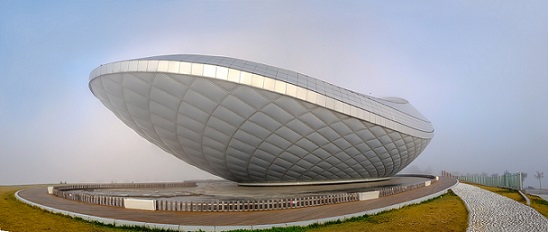
If there is a particular style of architecture that you like, focus on that one and learn appropriate vocabulary related to it. There may also be styles of architecture very specific to your own country.
If there’s a style of architecture common in your town or city, learn the buildings vocabulary that will enable you to talk about it easily.
Buildings Vocabulary Pronunciation
Buildings Vocabulary Set 6: Descriptions
elegant – graceful and stylish in appearance
- Amira loved the elegant lines of the building’s Art Deco façade.
stunning – extremely impressive or attractive
- Igor had doubts about the Futuristic design of the new library building but had to admit that it looked absolutely stunning when finished.
eye-catching – very attractive or noticeable
- She found the carved stone pillars particularly eye-catching.
ornate – covered with a lot of decoration, especially complicated designs
- It’s common for grand manor houses to have ornate ceilings.
a radical design – extreme
- Pilau liked his buildings to stand out and was well-known for his radical designs.
controversial – something that people have strong opinions about; something that people either love or hate
- The design of the new town hall was certainly controversial and strongly opposed by many people.
iconic – in architecture, a design that is 'ground-breaking' and sets new standards or a building that represents a particular style of architecture
- The Sydney Opera House is Australia’s most iconic building.
state of the art – incorporating the newest ideas and features
- The new hospital was state of the art and medical professionals from across the country were eager to work there.
spacious – having lots of space for people to move around in
- Older properties tend to have more spacious rooms than modern homes.
geometric – patterns or shapes consisting of regular shapes or lines
- Many styles of architecture incorporate geometric designs both for strength as well for decoration.
symmetrical – where one side is the same as the other
- If you cut a symmetrical design in half, one side is the mirror image of the other.
ugly / unsightly – unpleasant to look at; not attractive
- I think that the houses being built on many new housing estates are really ugly.
monstrosity – a thing, especially a building, which is very large and unsightly
- The civic centre in our town, of typical 1960’s design, is a total monstrosity and I wish they’d demolish it to build something more attractive.
eyesore – a building that is not attractive
fall into disrepair – to be in a damaged state, often to the extent that it is dangerous
- The cinema used to be a beautiful building but has become a bit of an eyesore since it fell into disrepair.
past its heyday – no longer at the peak of popularity or success
- Although Victorian architecture is past its heyday, Victorian townhouses are still very popular as they make spacious family homes.
derelict – in very poor condition as a result of disuse and neglect
demolish – completely destroy a building
They are going to demolish the derelict buildings down at the docks to make way for a development of new waterside apartments.
Buildings Vocabulary Pronunciation
Buildings Vocabulary Set 7: Improving a property
See my Home Vocabulary list for some home improvement words and phrases.
Here is some related buildings vocabulary:
preserve – to keep looking the same
- The National Trust is a charity in the UK that is dedicated to restoring and preserving historical buildings.
transform – to change something completely, usually to improve it
- The new owners transformed the derelict manor house into a stunning country hotel.
maintain – keep something in a good condition by checking and repairing it regularly
- Old buildings generally cost more to maintain than ones built with modern materials.
Buildings Vocabulary Pronunciation
Buildings Vocabulary Set 8: Buildings & the environment
energy efficient – using little electricity, gas, etc.
- These days, one of the most important considerations in building design and the choice of building materials is energy efficiency.
insulation – material used to stop heat escaping
- In cold climates, it’s important for buildings to be well insulated and glass fibre is often used as roof insulation.
double glazing – windows which have two layers of glass with a space between them, designed to reduce the loss of heat and exclude noise
- The first thing they did to improve the old property was to put in double glazed windows.
eco-friendly – not harmful to the environment
- Installing solar panels to cut down on the use of fossil fuels is one of the best ways to make your home eco-friendly.
wheelchair friendly – meets the needs of people who use a wheelchair in terms of access and internal services
- Historic houses that are open to the public are required to make alterations to ensure that they are as wheelchair friendly as is practically possible.
Buildings Vocabulary Pronunciation
Buildings Vocabulary Set 9: Basic vocabulary
exterior – the outside of something, especially a building
- The exterior of the pretty little cottage was painted pink.
interior – the inside of something, especially a building
- The cottage had small windows, making the interior quite dark.
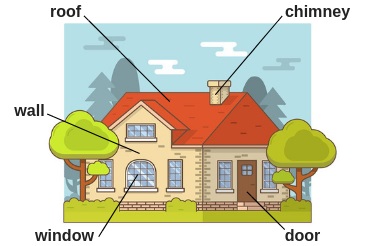
ceiling – the top inside surface of a room
- A popular feature of Georgian properties is their high ceilings which make rooms feel really spacious.
floor – the lower surface of a room that people walk on
- Bare floorboards are very popular in the homes of today but I prefer carpet as it makes floors warmer to walk on.
stairs – a long set of steps inside a building joining the different levels
- The children were told not to leave their toys on the landing in case someone tripped over them and fell down the stairs.
storey – a level of a building
- The three-storey house with an extra bedroom in the attic was perfect for Milek, Edyta and their four children.
fireplace – a space in the wall at the base of a chimney for a fire to burn
- When people renovate Victorian properties they often remove the old fireplaces but some keep them as decorative features.
For the vocabulary related to the different rooms in a house see my Home Vocabulary list.
Buildings Vocabulary Pronunciation
Buildings Vocabulary Set 10: Other vocabulary
blueprint – a design plan or other technical drawing
- Bruno and Claudia were so excited when the architect rang to say that the blueprints of their new house were ready for them to look at.
design – a plan or drawing produced to show the look of something, e.g. a building, before it is created
- Rahul worked closely with his clients to create a design that perfectly matched their idea of their dream home.
planning permission – formal permission from a local authority for the erection or alteration of a building
- It’s very difficult to get planning permission to make alterations to a historic building.
building site – an area of land on which a building or a group of buildings is in the process of being built or altered
- It was fascinating watching the muddy building site gradually transformed into a smart new housing estate.
to construct – to build
- It took five years to construct the Buri Khalifa skyscraper in Dubai.
to put up – to build
- They are putting up an ugly office block on the site of the lovely old theatre.
Buildings Vocabulary Pronunciation
Click this link to get a PDF download of this list of buildings vocabulary.
Ways to Improve Your Buildings Vocabulary
One of the best ways to improve your buildings vocabulary is through reading. Watching topic related YouTube videos and listening to podcasts is also hugely beneficial.
Here are some online resources I recommend.
Articles
Architecture Week - excellent resource with articles on just about any topic you could think of
The Independent - Architecture
TED Talks
I love TED Talks. They are short videos with a powerful message and are generally very interesting. They’re ideal for improving your vocabulary and give valuable listening skills practise.
Search TED Talks - Architecture to help you improve your buildings vocabulary.


